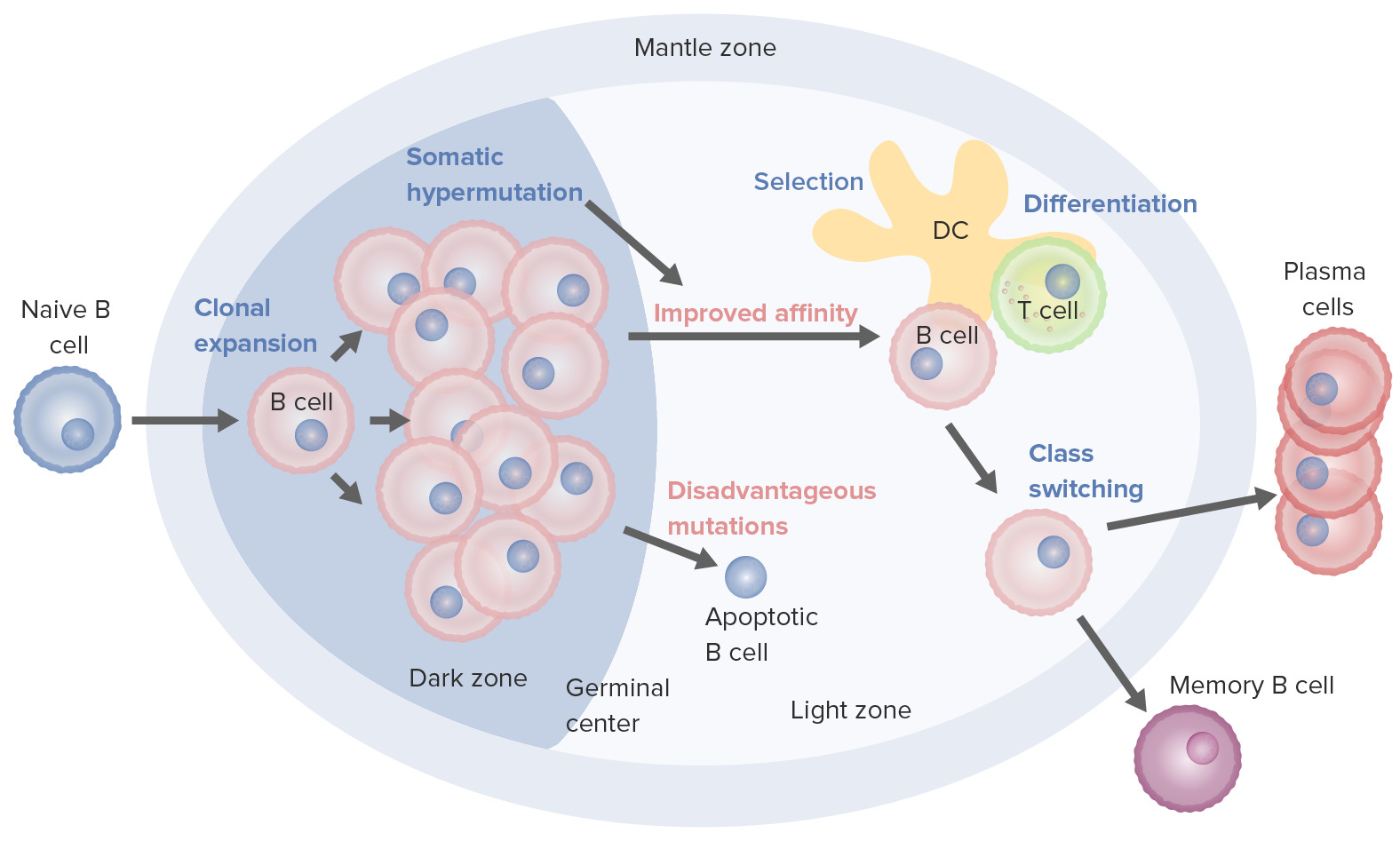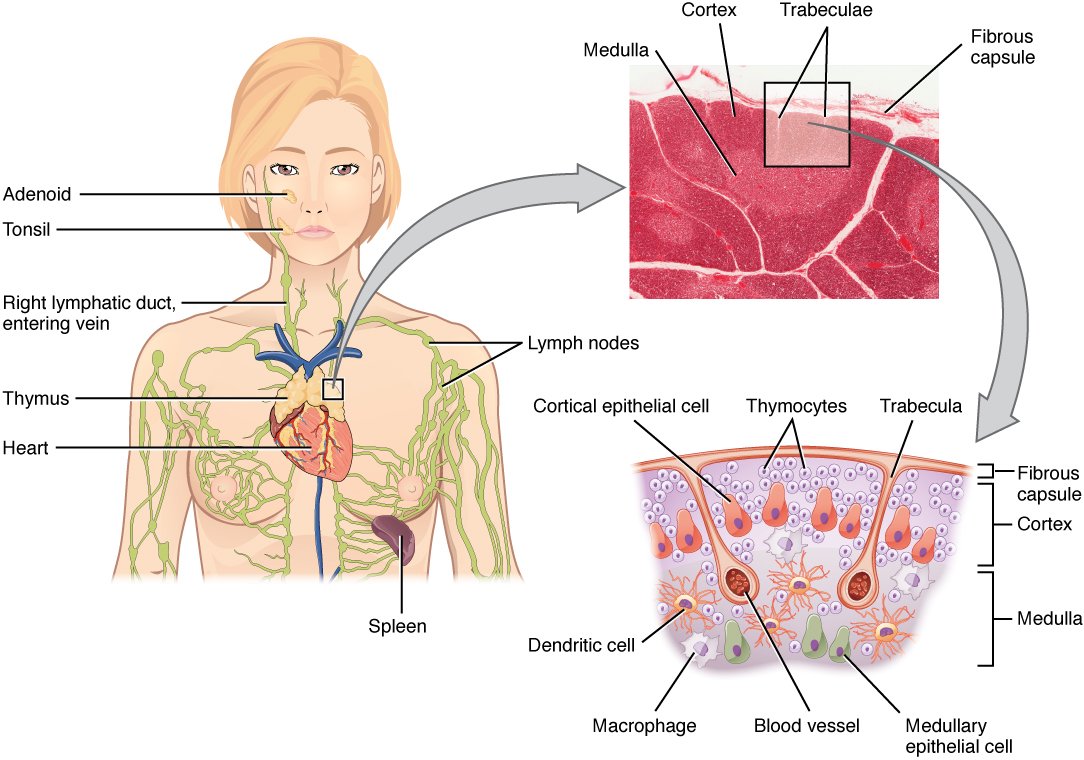Playlist
Show Playlist
Hide Playlist
B-Cell Differentiation – Lymphocyte Activation
-
Slides Lymphocyte Activation.pdf
-
Reference List Immune System.pdf
-
Download Lecture Overview
00:01 Because lymphocytes recombine their antigen receptor genes in a random way, it means that we can produce millions and millions and millions of different B-cell receptors on the surface of B-cells; and millions and millions of different T-cell receptors on the surface of the T-cells. 00:19 So that’s great, means that whatever pathogen comes along, if some new pathogen arises or if an existing pathogen undergoes mutation and changes its antigens, we should have some lymphocytes that have an antigen receptor specific for that particular pathogen. 00:36 However, that comes at a price. 00:38 This huge diversity of T-cells and huge diversity of B-cells means that for any given single pathogen, we don’t have millions and millions and millions of cells. 00:48 We may only have a few hundred or a few thousand. 00:51 It’s actually not enough to do the job of getting rid of the infection. 00:55 So there’s a problem there. 00:57 So how does the immune system get around that problem? Well, it does it by clonally selecting the B-cells and the T-cells that are required, then activating them and causing them to divide and divide and divide. 01:12 So that particular specificity will expand up. 01:15 So rather than having just a few thousand, let’s say T-cells and B-cells against Streptococcus for example; rather than just having a few thousand, you end up with millions, and that is enough to do the job that’s needed to eliminate the infection. 01:28 So clonal selection of lymphocytes is key to the way in which the adaptive immune response functions. 01:35 So here we have a B-cell in the middle, say five different B-cells with five different specificities of B-cell receptor. 01:42 And this one is specific for that particular virus that we can see there. 01:48 And it will become activated by the mechanisms that we’ve just reviewed, and part of that activation will initiate cell proliferation. 01:58 The cell will divide and it will divide and it will carry on dividing multiple times. 02:04 And expand up the number of cells so that a sufficient number is generated to eliminate the particular infection. 02:17 Once the cells become activated, not only do they proliferate, but they also differentiate. 02:23 So a naïve B-cell, one that has not previously encountered the antigen, if it encounters the antigen it’s specific for, it will become activated. 02:34 As part of that activation, proliferation will be induced following clonal selection. 02:40 And then the B-cell can differentiate down one of two different pathways. 02:48 Most of the B-cells will develop into plasma cells. 02:53 These are the antibody secreting version of the B-cell. 02:58 So a B-cell will differentiate into a plasma cell. 03:01 It has a rather different appearance to the B-cell. 03:04 It has more cytoplasm, which is why it’s called a plasma cell. 03:08 It has lots of rough endoplasmic reticulum which is the place where proteins are made in cells. 03:13 And this particular cell is going to make lots and lots and lots and lots of one particular protein, the antibody molecule. 03:19 So these plasma cells can now secrete vast amounts of antibody against the antigen that initially stimulated that particular B-cell. 03:28 So if this B-cell was against Cytomegalovirus, you’ll produce lots of antibody against Cytomegalovirus. 03:35 However not all of the B-cells differentiate into plasma cells. 03:39 Some of them will differentiate into memory B-cells. 03:43 And these cells are crucially important in developing a secondary immune response. 03:51 Characteristic feature of the adaptive immune response is that upon a subsequent encounter with the same antigen, the response is much faster. 04:00 And actually, not only is it faster but the quality of the response is much better as well. 04:06 And this property depends upon the generation of memory B-cells. 04:14 So memory B-cells provide the basis of the secondary immune response. 04:19 Looking here on this graph, we can see the magnitude of the response following the first encounter with a given antigen. 04:27 The adaptive immune response develops this primary immune response. 04:32 This term primary and secondary immune response there, it’s uniquely used for the lymphocyte responses. 04:37 It’s characteristic of the adaptive response. 04:40 Initially the primary immune response, it’s okay. 04:43 But it doesn’t make masses of antibody that… not masses of T-cells are produced, but it usually is sufficient to do the job. But on a second encounter with the same antigen, because during the first response memory cells were generated, the second response gets off the ground much faster. It goes to a much higher level and it stays up for much longer. So both qualitatively and quantitatively, secondary immune responses are superior to primary immune responses.
About the Lecture
The lecture B-Cell Differentiation – Lymphocyte Activation by Peter Delves, PhD is from the course Adaptive Immune System. It contains the following chapters:
- Clonal Selection of B-Cells
- B-Cell Differentiation
- Memory Cells
Included Quiz Questions
Which of the following options best compares primary immune response to secondary immune response?
- Primary is of lower magnitude than secondary.
- Secondary is slower to respond than primary.
- Secondary is less specific than primary.
- Unlike the secodary immune response, the primary form involves memory cells.
- Antibody levels decline more rapidly in the secondary form.
Which of the following best describes the process of clonal selection in immune response?
- How a single B or T cell specific to an antigen is selected and reproduced to generate a clonal cell population that eliminates the antigen
- How a single pathogen that infects an immune cell is presented to memory cells for eradication
- How a single infecting pathogen selects and proliferates within a specific clone of immune cells.
- How the innate immune system mounts a response to different antigens in the same fashion.
Which of the following cells differentiate from a naive B cell after exposure to a specific antigen?
- Plasma cells and memory B cells
- Plasma cells and natural killer cells
- Cytotoxic T cells and natural killer cells
- Cytotoxic T cells and plasma cells
- Memory B cells and natural killer cells
Which of the following best describes the key role of memory B cells in the human adaptive immune response?
- They are responsible for mounting the secondary immune response.
- They produce antigen-specific antibodies more efficiently than other types of cells.
- They recruit T cells to help respond to antigens.
- They secrete cytokines which cause naive B cells to differentiate into a specific antigen target.
- They initiate and maintain a primary immune response.
Customer reviews
5,0 of 5 stars
| 5 Stars |
|
2 |
| 4 Stars |
|
0 |
| 3 Stars |
|
0 |
| 2 Stars |
|
0 |
| 1 Star |
|
0 |
Amazing lecture! This course has been a great help for my studies. Thank you, Prof. Peter Delves!
I felt that this was a very good lecture, with detailed relevant information!





